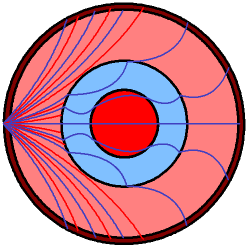
gcsescience.com 61 gcsescience.com
What are P Waves and S Waves?
The
two types of wave which travel through the planet from
an earthquake are called P waves and S waves.
S waves
are transverse. P
waves are longitudinal.
P waves travel faster than S
waves.
In the
picture below
P waves are shown in
blue and S waves are shown in
red.
The earthquake has occurred on the
left side of the planet,
the waves are moving from left to right.

How do P Waves and
S Waves
give Information about the Structure of the Earth?
The transverse S waves
cannot travel through the liquid outer core.
They can travel through the mantle because the mantle behaves
more like a
solid than a liquid.
The S waves
curve as they move
through the mantle
due to refraction as the density of the
mantle
changes. There is a large part of the surface
of the planet where
no S waves are detected.
This shows that the outer core
is liquid
because it blocks S waves.
It also shows how big the outer
core is.
The longitudinal P waves can travel through the
whole planet.
They also curve with the changing density of both the mantle
and the core (except the wave passing through the
centre,
which travels in a straight line, normal to the boundary).
The P waves change direction suddenly at the
boundary
between the
different layers of the Earth. This is due to
refraction caused by
the different
densities of the layers.
The P waves show how big
the solid
inner core is.
![]() Links
Waves
Plate Tectonics
Revision Questions
Links
Waves
Plate Tectonics
Revision Questions
![]()
gcsescience.com Physics Quiz Index Earthquake Quiz gcsescience.com
Home GCSE Chemistry GCSE Physics
Copyright © 2015 gcsescience.com. All Rights Reserved.